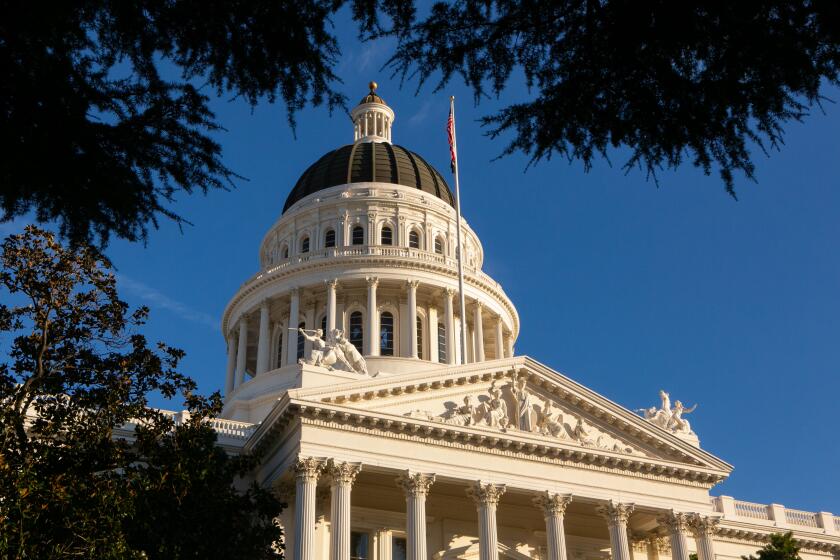Opinion: How California can get on the right path and give Latinos a bigger voice in government

- Share via
One of Gov. Gavin Newsom’s primary responsibilities is appointing individuals to fill vacancies within state boards and commissions. However, his office lacks a public system to check whether these appointees reflect the communities they are meant to serve.
Regrettably, these seats often fail to mirror the diversity inherent to California, particularly when it comes to the underrepresentation of Latinos. Despite making up 39% of the population, Latinos remain marginalized within these appointments, and lack of transparency around data on the governor’s appointments obscures the true extent of this underrepresentation.
Many Latinos have worked hard to move past colorism and racism. Anyone who isn’t doing that work should not hold office.
There is a promising solution before us. Senate Bill 702, authored by state Sen. Monique Limón (D-Santa Barbara), would require the office of the governor to create and publish an annual report on the demographic composition of all appointees made that year to state boards and commissions. This report would offer the transparency needed for targeted advocacy to diversify boards and commissions that wield significant influence across the state.
From overseeing access to retirement for public educators through the California State Teachers’ Retirement System, to cleaning contaminated lands in vulnerable communities through the Board of Environmental Safety, to the review authority of the Workers’ Compensation Appeals Board, these bodies sit at the nexus of the governor’s administrative powers and his wide oversight of issues affecting our communities.
Now an established force in the Legislature, the Democratic Latinos are facing pressure to refocus their priorities.
Last year, the UCLA Latino Policy and Politics Institute, where I work, released an analysis of Latino representation in the governor’s appointments to 45 critical commissions within the state’s agencies and departments. The report found that Latinos have the largest representation gap among all racial groups, filling only 18.4% of executive appointments — more than twice as many would be needed to accurately reflect the number of Latinos in the state. Among women, Latinas remain the most severely underrepresented.
In practical terms this means that these commissions are not accurately representing the communities they are supposed to serve. Latino students make up the majority of California’s K-12 educational system, but the community is underrepresented on educational boards. Similarly, Latino communities bear the brunt of many of the state’s environmental burdens, yet there is a stark absence of their voices within the state’s environmental commissions. Moreover, while they are a driving force in the state’s labor growth and job creation, Latinos lack substantial representation on workforce development boards.
SB 702 is at a critical juncture as another legislative session draws to an end. Last year the bill was vetoed by Newsom, who cited budget constraints. The governor has a commendable track record of historic gubernatorial appointments, including installing the state’s first Black secretary of state, its first attorney general of Filipino descent and the first Latino U.S. senator to represent California. But the public deserves to know what progress is being achieved across all appointments, including the most obscure. If the bill is not passed, it limits our ability to understand what constituencies are absent from decision-making.
Fatalities along the Rio Grande are disturbing, but it’s not at all clear they’ll affect the outcomes of coming elections.
As a state whose economic progress and success are entwined with the Latino community, we must undertake rigorous efforts to monitor, understand and rectify the pattern that consigns Latinos to the periphery of consequential decision-making bodies. Whether it’s corporate tech boards, nonprofit boards, Hollywood or the medical profession, the absence of Latino representation persists. Newsom can help write a new chapter for state boards and commissions. Additionally, this legislation can provide data and resources to organizations such as ours that advocate for the short-and long-term empowerment of Latinos and other underrepresented groups across the state.
Effective governance necessitates the presence of women, diverse populations and the inclusion of lived experiences as forms of expertise. Illinois has already implemented a similar law, which will provide a tool for community leaders advocating for greater representation in their state. Now, California stands poised to meet this moment.
An annual report that tracks the makeup of state commissions and boards will help us put those resources where they are most needed, so that those doing the work that most affects our communities are indeed a reflection of those they are intended to serve.
Cesar Montoya is the senior policy analyst for the UCLA Latino Policy & Politics Institute.
More to Read
A cure for the common opinion
Get thought-provoking perspectives with our weekly newsletter.
You may occasionally receive promotional content from the Los Angeles Times.













